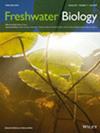潜水交换对黄土高原北罗河微生物群落结构和功能的影响——以北罗河为例
IF 2.8
2区 生物学
Q2 ECOLOGY
引用次数: 0
摘要
河流潜流带微生物群落提供重要的生态系统服务。然而,在不同的生境压力条件下,它们对低循环水交换的反应机制仍然知之甚少。因此,研究河流潜流交换对微生物群落组成及其潜在生态功能的影响是必要的,特别是在中国北方季节性河流中。为了阐明潜流带沉积物微生物群落在响应潜流交换和环境波动中的结构和功能,我们通过原位降水头渗透率测试和eDNA技术研究了它们之间的联系。结果表明:(1)不同监测站间河床导水率(0.055 ~ 3.490 m/d)和垂直通量(1.886 ~ 342.0 mm/d)的空间分布格局存在差异。(2)微生物群落具有相似性和空间异质性。垂直交换有限的站点物种多样性降低。(3)与真核生物群落相比,原核生物具有更好的模块化特征,具有更高的稳定性和功能多样性。(4)不同生境间微生物代谢和遗传功能丰度存在差异。本研究强调了当地水文模式(如下坡)在维持河流环境要素和作为潜流带内微生物多样性热点方面的重要性。潜水交换水文模式的异质性可以解释该区域微生物的丰度、物种多样性和生物地球化学过程。本文章由计算机程序翻译,如有差异,请以英文原文为准。
Effects of Hyporheic Water Exchange on Microbial Community Structure and Function: A Case Study in the Beiluo River, Loess Plateau, China
- Microbial communities in riverine hyporheic zones provide essential ecosystem services. However, the mechanisms whereby they respond to hyporheic water exchange under different habitat stress conditions remain poorly understood. Therefore, investigating the impact of riverine hyporheic exchange on the microbial community composition and its potential ecological function is essential, particularly in the seasonal rivers of northern China.
- To elucidate the structure and function of hyporheic zone sediment microbial communities in response hyporheic exchange and environmental fluctuations, we examined associations by performing in situ falling-head permeameter tests and eDNA techniques.
- The primary findings were as follows: (1) We detected variations in the spatial distribution patterns of streambed hydraulic conductivity (range, 0.055–3.490 m/day) and vertical fluxes (range, 1.886–342.0 mm/day) among different monitoring stations. (2) Microbial communities displayed compositional similarities and spatial heterogeneity. Stations with limited vertical exchange were characterised by reduced species diversity. (3) Prokaryotes showed better modularity characteristics with higher stability and functional diversity than eukaryotic communities. (4) Differences in the abundance of microbial metabolism and genetic functions were observed among different habitats.
- This study emphasises the significance of local hydrological patterns (such as downwelling) in maintaining riverine environmental elements and acting as hotspots for microbial diversity within the hyporheic zone. The heterogeneity of the hydrological patterns governing hyporheic water exchange can explain the abundance, species diversity and biogeochemical processes of microorganisms within this zone.
求助全文
通过发布文献求助,成功后即可免费获取论文全文。
去求助
来源期刊

Freshwater Biology
生物-海洋与淡水生物学
CiteScore
5.90
自引率
3.70%
发文量
162
审稿时长
2 months
期刊介绍:
Freshwater Biology publishes papers on all aspects of the ecology of inland waters, including rivers and lakes, ground waters, flood plains and other freshwater wetlands. We include studies of micro-organisms, algae, macrophytes, invertebrates, fish and other vertebrates, as well as those concerning whole systems and related physical and chemical aspects of the environment, provided that they have clear biological relevance.
Studies may focus at any level in the ecological hierarchy from physiological ecology and animal behaviour, through population dynamics and evolutionary genetics, to community interactions, biogeography and ecosystem functioning. They may also be at any scale: from microhabitat to landscape, and continental to global. Preference is given to research, whether meta-analytical, experimental, theoretical or descriptive, highlighting causal (ecological) mechanisms from which clearly stated hypotheses are derived. Manuscripts with an experimental or conceptual flavour are particularly welcome, as are those or which integrate laboratory and field work, and studies from less well researched areas of the world. Priority is given to submissions that are likely to interest a wide range of readers.
We encourage submission of papers well grounded in ecological theory that deal with issues related to the conservation and management of inland waters. Papers interpreting fundamental research in a way that makes clear its applied, strategic or socio-economic relevance are also welcome.
Review articles (FRESHWATER BIOLOGY REVIEWS) and discussion papers (OPINION) are also invited: these enable authors to publish high-quality material outside the constraints of standard research papers.
 求助内容:
求助内容: 应助结果提醒方式:
应助结果提醒方式:


